NCERT Solutions for Class 9 Science Chapter 11 - Sound
Have you ever observed that, though when the phone is outside in the air, you can hear the phone ringing well, when the phone is in a vacuum jar, you cannot hear it at all? This is because the waves of sound require a substance like air, water or solids to travel in, and they cannot travel in a vacuum. These interesting concepts can be discussed in detail in the NCERT Solutions of Class 9 Science Chapter 11- Sound, where the students get to know how sound is produced by vibrations and how it gets to our ears.
This Story also Contains
- Class 9 Science Chapter 11 - Sound Question Answers: Download Solution PDF
- NCERT Solutions for Class 9 Science Chapter 11 - Sound: Exercise Questions
- Sound Class 9 NCERT Solutions: Additional Questions
- Class 9 Science Chapter 11 - Sound: Higher Order Thinking Skills (HOTS) Questions
- NCERT Solutions for Class 9 Physics Chapter 11: Topics
- NCERT Solutions for Class 9 Science Chapter 11 - Sound: Important Formulas
- Approach to Solve Questions of Class 9 Science Chapter 11 - Sound
- Benefits of NCERT Solutions for Class 9 Science Chapter 11 - Sound
- NCERT Solutions for Class 9 Science Chapter-wise
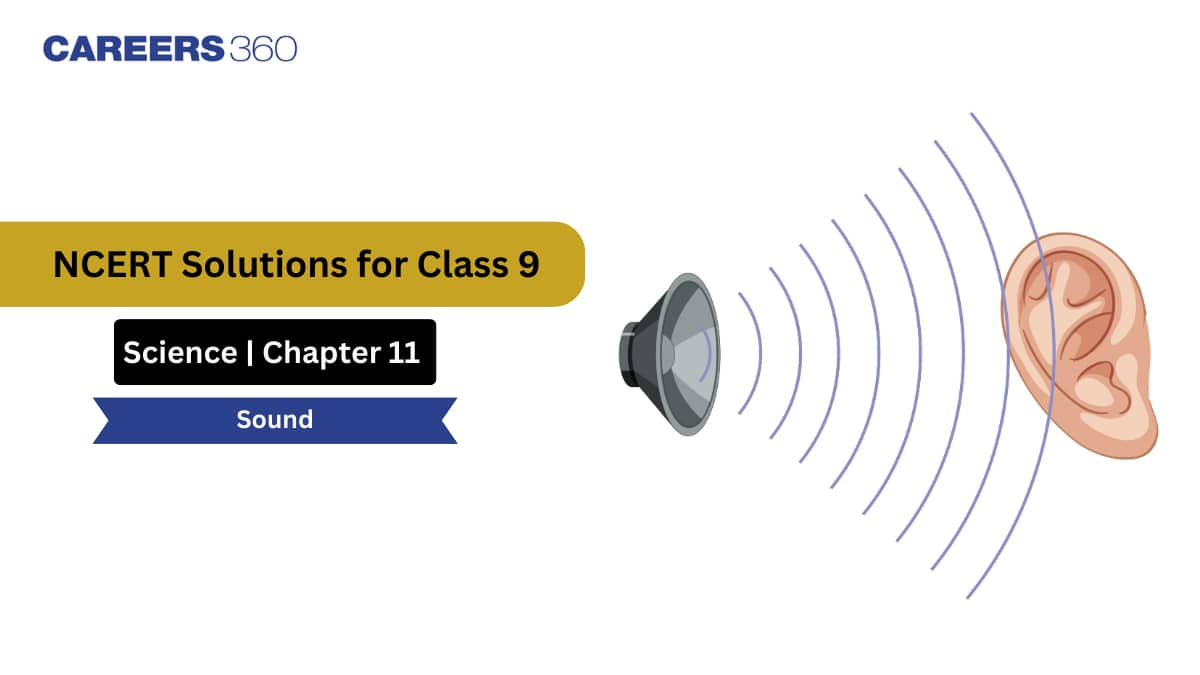
The NCERT Solutions for Class 9 Science Chapter 11 - Sound present answers in a step-by-step manner, which makes the various crucial concepts, such as the nature of sound waves, frequency, amplitude, pitch, and loudness, simple enough and the fact that sound does not travel in a vacuum. These NCERT Solutions for Class 9 Science Chapter 11 - Sound also comprise the Higher Order Thinking Skills (HOTS) questions, and significant formulas, which enhance exam preparation, in addition to the well-designed solutions to textbook exercises. Through these NCERT solutions, the students not only revise important concepts efficiently, but they also learn how to solve numerical problems and theoretical questions correctly. Moreover, the chapter also underlines the uses of sound in daily life, communication, and technology, which makes it very helpful in CBSE school exams as well as competitive exams such as NTSE and Olympiads.
Also Read,
Class 9 Science Chapter 11 - Sound Question Answers: Download Solution PDF
Class 9 Science Chapter 11 - Sound question answers offer well structured step-by-step answers to all the questions in the NCERT textbook on sound, and therefore students find it easier to acquire essential knowledge of producing sound through vibrations, the propagation of sound waves, the properties of sound frequency, amplitude, pitch, and loudness, and the reason why sound cannot be propagated in a vacuum. The NCERT solutions are drawn according to the recent CBSE syllabus to enable the students to develop well-rounded fundamentals, revise in an organised way and achieve good grades in the exams. Get the Class 9 Science Chapter 11 Question Answers on Sound, in a free PDF by clicking below:
NCERT Solutions for Class 9 Science Chapter 11 - Sound: Exercise Questions
Sound Class 9 question answers are set to ease the learning of the production, propagation, and properties of sound for students. These solutions are helpful in exam preparation, quick revision and also in creating a strong basis in physics with answers to all the questions in textbooks.
Q.1. What is sound and how is it produced?
Answer:
A sound is a form of energy that is produced by the vibrations of objects.
It is produced by the to-and-fro motion of the object. The vibrations are created, which causes a disturbance in the adjacent particles of the medium. The disturbance travels in the waveform and creates sound.
Answer:
The compression and rarefactions produced in air near the source of sound (Here the prong) are shown in the diagram below:
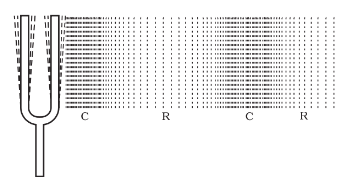
Here C is for Compression and R is for Rarefaction.
Answer:
Longitudinal waves are formed when oscillation is created parallel to the disturbance of the particles of the medium in the direction of propagation, and since sound waves also create oscillations in the particles of the medium parallel to the disturbance in the direction of propagation.
Therefore, sound waves are called longitudinal waves.
Answer:
The quality of timber of the sound is that characteristic which enables us to distinguish one sound from another having the same pitch and loudness.
Thus, because of the difference in timbre and pitch of the sound wave, we can identify the voices of friends.
Answer:
This happens because of the difference in the velocities of light and sound waves. Light travels much faster than sound. That is the reason why we hear the thunder a few seconds after the flash of thunder is seen, instead of both being produced simultaneously.
Answer:
Taking the speed of sound in air as
Then,
We know:
Or,
Hence,
For
and for
Hence, the hearing wavelength range for humans is
(Given: Speed of sound in air is
Answer:
Here, let us assume the length of the rod to be
Then,
Time taken by the sound wave in air:
Time taken by the sound wave in Aluminium to reach from one end to the other end,
Therefore, the ratio of the time taken by the sound wave in air and in aluminium will be:
Hence, the ratio is
Q8. The frequency of a source of sound is 100 Hz. How many times does it vibrate in a minute?
Answer:
Given that the frequency of the sound wave is 100Hz.
Frequency is the number of oscillations per second.
So, 100Hz means that 100 oscillations are done in 1 second.
Thus, in a minute, the number of oscillations would be,
Q.9. Does sound follow the same laws of reflection as light does? Explain.
Answer:
Yes, the sound wave also follows the same laws of reflection as light does. Which are as follows:
(i) The angle of incidence of the sound wave and the angle of reflection of the sound wave to the normal are equal.
(ii) The incident sound wave, the reflected sound wave and the normal at the point of incidence all lie in the same plane.
Q10. When a sound is reflected from a distant object, an echo is produced. Let the distance between the reflecting surface and the source of sound production remains the same. Do you hear echo sound on a hotter day?
Answer:
Listening to the sound of an echo depends upon the time interval between the source of a sound and the reflecting surface, which should be at least 0.1 seconds.
The speed of sound increases with an increase in the temperature of the medium. Hence, on a hotter day, the time interval between the source sound and the reflected sound will decrease.
Therefore, we cannot listen to the echo unless the interval is greater than 0.1 seconds.
Q11. Give two practical applications of reflection of sound waves.
Answer:
Two practical applications of sound waves are :
(i) In the stethoscope, the sound of the patient's heartbeat reaches the doctor's ears by multiple reflections throughout the pipe of the stethoscope of sound.
(ii) Horns, megaphones or loudhailers are designed to send sound in a particular direction without spreading it in all directions. There is a conical opening which reflects the sound waves and guides most of the sound waves from the source.
Q12. A stone is dropped from the top of a tower 500 m high into a pond of water at the base of the tower. When is the splash heard at the top? Given
Answer:
Given the height of the tower,
and the velocity of the sound,
Acceleration due to gravity,
Let the initial velocity of the stone,
Let the time taken by the stone to fall to the base of the tower be
Now, according to the Second Equation of Motion:
Now, the time taken by the sound to reach the top from the base of the tower,
Therefore, the splash is heard at the top after time,
Calculating
Answer:
Given,
The speed with which sound travels is
and the wavelength is 1.5 cm.
Then we know the relation,
Where,
Hence,
Calculated frequency is out of the audible range of human ears, which is
Therefore, it is inaudible.
Q.14. What is reverberation? How can it be reduced?
Answer:
Reverberation is the repeated reflection after the source stops producing a sound, which is also known as persistence of sound. When the wave reaches the wall of a room, it is partly reflected back from the wall. This reflected sound then reaches the other wall and again gets reflected partly. Due to this, sound can be heard even after the source has ceased to produce sound.
To reduce the reverberation, sound must have to be absorbed as it reaches the walls and the ceilings of a room. Materials like wood, fibreboard, rough plastic, heavy curtains, and some seats can be used to reduce the reverberations.
Q15. What is the loudness of sound? What factors does it depend on?
Answer:
Loudness is a physiological response of the ear to the intensity of sound, which enables us to distinguish between a soft sound and a loud sound.
The loudness or softness of a sound is determined basically by its amplitude, and loudness is proportional to the square of the amplitude of the vibrations.
Where greater the amplitude of vibrations, the louder the sound is produced.
Q16. How is ultrasound used for cleaning?
Answer:
The object to be cleaned is first put in the cleaning solution, and then the ultrasonic waves are passed through that solution. The high-frequency ultrasonic waves are capable of removing dirt from objects very easily.
Q17. Explain how defects in a metal block can be detected using ultrasound.
Answer:
Ultrasounds can be used to detect cracks and flaws in metal blocks. Metallic components are generally used in the construction of big structures like buildings, bridges, machines and also scientific equipment. The cracks or holes inside the metal blocks, which are invisible from the outside, reduce the strength of the structure. Ultrasonic waves are allowed to pass through the metal block, and detectors are used to detect the transmitted waves. If there is even a small defect, the ultrasound gets reflected back, indicating the presence of the flaw or defect, as shown
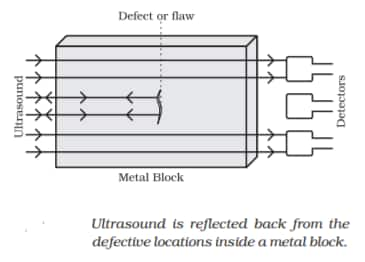
Sound Class 9 NCERT Solutions: Additional Questions
The Sound NCERT Solutions: Additional Questions provide extra problems outside the textbook to reinforce the knowledge of such concepts as vibration, frequencies, pitch, and the speed of sound. These organised, meaningful questions will enable students to improve their problem-solving ability and go in for exams confidently.
Q1. Explain the working and application of a sonar.
Answer:
Working of SONAR:
Sonar consists of a transmitter and a detector and is installed in a boat or a ship, as shown in the Figure below:
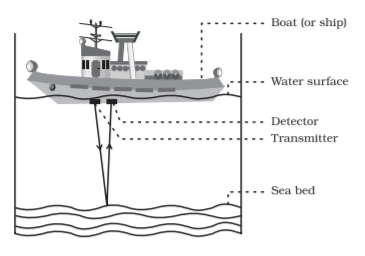
The transmitter produces and transmits ultrasonic waves. These waves travel through water and, after striking the object on the seabed, are reflected back and are sensed by the detector. The detector converts the ultrasonic waves into electrical signals, which are appropriately interpreted. The distance of the object that reflected the sound wave can be calculated by knowing the speed of sound in water and the time interval between the transmission and reception of the ultrasound.
Applications of SONAR:
The sonar technique is used to determine the depth of the sea and to locate underwater hills, valleys, submarines, icebergs, sunken ships, etc.
Answer:
Given that the distance of the object is 3625 m from the submarine, and the time taken is 5 seconds.
But the time given includes both the journey downward and upward,
hence the time taken will be half of this time.
And as
Putting the values in the equation, we get
Therefore, the speed of sound is 1450 m/s.
Q3. Explain how bats use ultrasound to catch prey.
Answer:
Bats emit very high-frequency sounds from their mouth, which, when they touch the prey, and gets reflected back to the bat. Then the bat detects these waves and estimates the distance and the direction of the prey.
Q4. Explain how the human ear works.
Answer:
The outer ear is called the ‘pinna’. It collects the sound from the surroundings. The collected sound passes through the auditory canal. At the end of the auditory canal, there is a thin membrane called the eardrum or tympanic membrane. When compression of the medium reaches the eardrum, the pressure on the outside of the membrane increases and forces the eardrum inward. Similarly, the eardrum moves outward when a rarefaction reaches it. In this way, the eardrum vibrates. The vibrations are amplified several times by three bones (the hammer, anvil, and stirrup) in the middle ear. The middle ear transmits the amplified pressure variations received from the sound wave to the inner ear. In the inner ear, the pressure variations are turned into electrical signals by the cochlea. These electrical signals are sent to the brain via the auditory nerve, and the brain interprets them as sound.
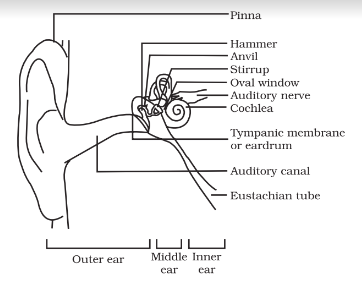
Class 9 Science Chapter 11 - Sound: Higher Order Thinking Skills (HOTS) Questions
The Class 9 Science Chapter 11 - Sound: Higher Order Thinking Skills (HOTS) Questions are designed to challenge students with advanced problems related to sound waves, vibrations, and their applications. These questions go beyond basic concepts, encouraging logical reasoning, deeper analysis, and exam-oriented preparation.
Q.1 On average, a human heart is found to beat 85 times in a minute. Calculate its time period.
Answer:
The beat frequency of the heart
The period
Q.2 The velocity of sound in a gas at 51°C is 340m/s. What will be the velocity of sound if the pressure is doubled and the temperature becomes 127°?
Answer:
Initial temperature:
Final temperature:
We know that
Q.3 If the temperature of the atmosphere is increased, the following characteristics of the sound wave are affected
(a) Amplitude
(b) Frequency
(c) Velocity
(d) Wavelength
Answer:
wherein
So, velocity increases with an increase in temperature.
Hence, the answer is option (3).
NCERT Solutions for Class 9 Physics Chapter 11: Topics
The NCERT Solutions for Class 9 Science Chapter 11 - Sound include all the relevant topics connected with the production, transmission, and characteristics of sound waves. These solutions feature a step-by-step explanation of every concept, providing students with the opportunity to further consolidate their foundations and adequately prepare to write exams.
11.1 Production of Sound
11.2 Propagation of Sound
11.2.1 Sound Waves are Longitudinal Waves
11.2.2 Characteristics of a Sound Wave
11.2.3 Speed of Sound in Different Media
11.3 Reflection of Sound
11.3.1 Echo
11.3.2 Reverberation
11.3.3 Uses of Multiple Reflections of Sound
11.4 Range of Hearing
11.5 Applications of Ultrasound
NCERT Solutions for Class 9 Science Chapter 11 - Sound: Important Formulas
Class 9 Science Chapter 11 - Sound question answers Important Formulas will cover all the important formulas, which should be known by students when solving numerical problems and answering questions on different topics such as the speed of waves, frequencies, wavelengths of waves and echoes. These formulas make learning easy and can be used as a writing revision guide.
1. Speed, Frequency, and Wavelength of Sound
2. Relation between Time Period and Frequency
3. Echo Formula
Approach to Solve Questions of Class 9 Science Chapter 11 - Sound
The NCERT Class 9 Science Chapter 11 Sound shows the students the basic principles of sound production and the way sound travels in various media, and how we hear sound. In order to overcome the problems in this chapter efficiently, students should pay attention not only to the conceptual knowledge but also to the numbers. Here's the right approach:
- Know the fundamentals of sound production: Begin with the idea of vibrations, the way sound is produced and the need to have a medium through which sound is propagated.
- Concentrate on Sound Wave Characteristics: Be detailed in amplitude, frequency, wavelength, speed, pitch, and loudness. These properties are often tested by asking questions.
- Learn the Wave Equations: Revise and practice equations such as v = f x λ and equations involving the speed of sound in various media. These play a crucial role in numerals.
- Make use of Diagrams wherever possible: Practice ray diagrams showing compressions and rarefactions, sound propagation, and the structure of the human ear.
- Link with Real-Life Examples: To simplify the explanations, relate concepts with the everyday uses of concepts like echoes, SONAR, musical instruments and sound in communication.
- Revise Major Definitions and laws: Be accurate when describing terms such as oscillation, echo, reverberation and sound intensity. This enhances the precision of questions in short answers.
- Practice Numericals on a regular basis.: Work on problems in exercises and other numerical problems about: speed, frequency, and wavelength to gain confidence.
Benefits of NCERT Solutions for Class 9 Science Chapter 11 - Sound
Sound Class 9 question answers give a student a well-structured step-by-step answer to all questions of the textbook and thus making the concept of sound easy to learn and understand. These solutions describe key concepts like sound production, wave propagation, sound nature, echo, SONAR and the ear of a human being in a simplified form. They are built according to the most recent CBSE syllabus, which proves effective in equipping the students to take exams with confidence.
- Good Concept Clarity Level - Specifically, assists students in appreciating how sound is produced, travels and is heard using a series of easy solutions.
- Exam Preparation- Prepares students with all NCERT exercise questions and additional practice, getting them ready to take competitive board exams offered by CBSE.
- Application-Based Learning- Describes the practical applications of sound waves, echo, and SONAR so that concepts become easier to relate.
- Formula Support - All the valuable formulas are given topic-wise, and this helps a lot in solving numerical problems in no time.
- Time-Saving - Properly organised solutions save the time spent on revision as direct answers and key points are provided in one place.
- Increases Confidence- HOTS and other questions enhance critical thinking and help students be prepared to take competitive tests like NTSE and Olympiads.
- Step-by-Step Problem Solving - Teaches students to answer numerical and theoretical questions systematically.
NCERT Solutions for Class 9 Science Chapter-wise
NCERT Solutions for Class 9 Science Chapter-wise links provide easy access to all chapters in one place, making learning simple and organised. These solutions cover every exercise question with step-by-step answers, helping students prepare effectively for exams and build strong concepts in Physics, Chemistry, and Biology.
NCERT Solutions for Class 9 - Subject Wise
Also Check NCERT Books and NCERT Syllabus here:
Frequently Asked Questions (FAQs)
More questions on NCERT Class 9 chapter Sound can be solved from NCERT Exemplar questions for Class 9
Yes, the Class 9 Science Chapter 12 Exercise Question Answer PDF provides complete solutions to the chapter's problems, designed as per the latest NCERT curriculum.
The Sound Chapter Class 9 PDF includes important definitions, diagrams, solved questions, and summaries, making it a helpful tool for revision and understanding the chapter.
The Class 9 Science Chapter 11 Sound Exercise Question Answer PDF is available on Careers360 and includes step-by-step solutions to all textbook questions, making exam revision easy and quick.
Class 9 NCERT science chapter has 17 exercise questions, solutions of these questions are explained in the NCERT solutions of Sound Class 9 chapter. All the questions are according to the CBSE NCERT syllabus of Class 9.
Courses After 12th
Applications for Admissions are open.
As per latest syllabus. Physics formulas, equations, & laws of class 11 & 12th chapters
JEE Main Important Chemistry formulas
Get nowAs per latest syllabus. Chemistry formulas, equations, & laws of class 11 & 12th chapters
JEE Main high scoring chapters and topics
Get nowAs per latest 2024 syllabus. Study 40% syllabus and score upto 100% marks in JEE
JEE Main Important Mathematics Formulas
Get nowAs per latest syllabus. Maths formulas, equations, & theorems of class 11 & 12th chapters
